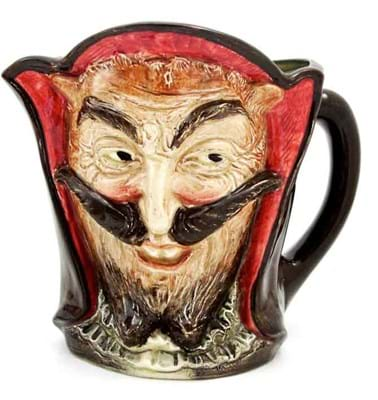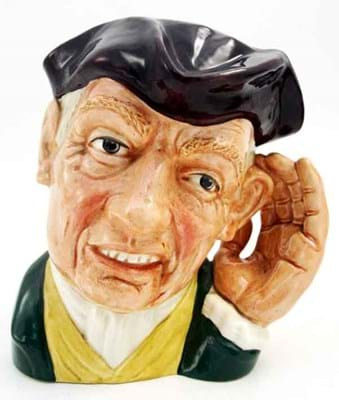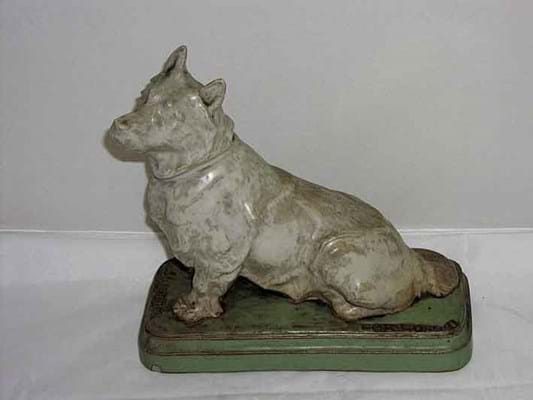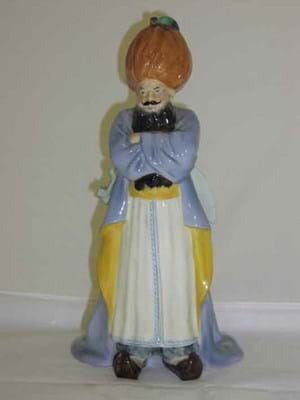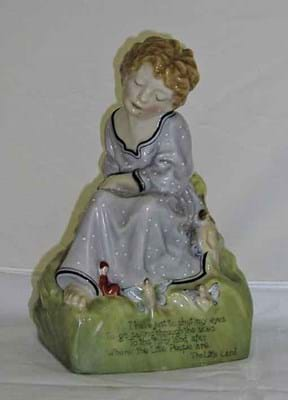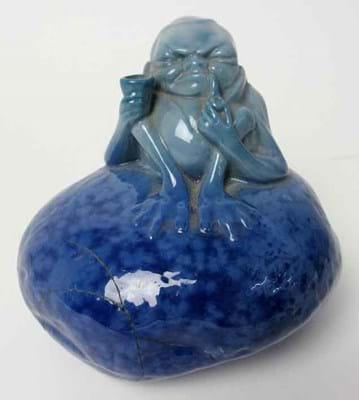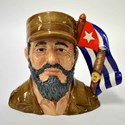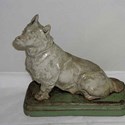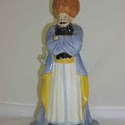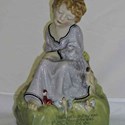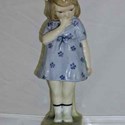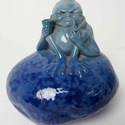But, as a clutch of recent sales have proved, rarities appealing to the top tier of Doulton collectors are a different matter entirely.
On August 29, Plymouth Auction Rooms (20% buyer's premium) sold a collection of just 30 character jugs for £21,400.
The collection of limited editions from the UK International Ceramics stable and the occasional fabled rarity had been pieced together by a Plymouth man over the last 20 years but the arrival of two young children had prompted the decision to sell. Bids were taken from Australia, Italy, America and the UK.
The 'hen's teeth' entry in the group was a Fidel Castro jug - one of only three produced as a prototype for collectables dealership UK International Ceramics. Each one has a different colour shirt - this revolutionary leader wore a fetching cream. It was seemingly the first time the Castro jug had come onto the open market and it did not disappoint, selling to an Australian buyer over the internet at £6900. The estimate was £5000.
Many of the jugs here were numbered issues made for UK International Ceramics in editions of 100. Subject matter counts and some proved more popular than others.
Sold at £800 was General Erwin Rommel (numbered 90/100) from the Great Generals Collection while Franklin D. Roosevelt (68/100) from the WWII Politicians series and General William Sherman (2/100) from the American Civil War Collection took £650 apiece.
However, also from series limited to 100 jugs were Dr Zhivago (£190) and Lara (£130). Hardly auspicious sums.
Generally speaking the larger the edition the cheaper the jug - it gives some idea as to the size of the collecting base that the series of Elvis jugs produced in editions of 1700 struggled to bring £50 each - but Ronald Reagan is an exception. Such is the following for the Great Communicator that this jug - the most desirable jug in the US Presidential Collection that was 'limited' to 5000 pieces - sold at £380.
The Jesse Owens character jug was issued as the Character Jug of the Year for 1996, to commemorate the Olympic Games in Atlanta, Georgia. Although only in production for a year the standard issue with its handle modelled as the Olympic torch wrapped in the Stars and Stripes sells for £50-100 but the version here was a colourway painted with the Olympic flag. It took £1000.
Among the classic rarities in the collection was a version of the Clark Gable character jug, produced for the US market as part of a 1984 Hollywood greats series.
It is estimated around 2000 were sent to America before the likeness had been approved by his estate. Contractual difficulties followed and Doulton stopped further production and recalled and destroyed all those unsold. The 100 or so survivors typically sell for around £2500, so the £3000 achieved here was a good result.
Wife's Suggestion
Macclesfield firm Adam Partridge (18% buyer's premium) sold over 400 Royal Doulton character jugs as part of their September 27-28 sale. It was the end of a 20-year collecting odyssey for one Newcastle upon Tyne enthusiast whose wife had "suggested" it was time for them to go.
Most were relatively common issues (the type that have been hit hard by the advent of eBay and mass online trading) and, in keeping with the market as a whole, sold for around £35 each, but a handful brought substantially more.
Three of these were made in the immediate pre- and post-War eras when, due to wartime restrictions, output was minimal. They included the large-sized version of The Cavalier, a jug designed by Harry Fenton, and based upon the famous portrait in the Wallace collection by Frans Hals, issued between 1940 and 1950. A very similar 'style two' jug, but without the goatee was produced from 1950 to 1960 and is much easier to find.
The Cavalier with Goatee took £820 - a decent sum but in fact no more than it might have made 20 years ago. In truth prices for many Doulton character jugs have slipped substantially in the two decades Adam Partridge's vendor had collected.
There are four recognised variations of the Hatless Clown jug, designed by Harry Fenton and issued 1951-55, those with red, brown, white or black hair. A White Haired Clown sold here for £180 (they used to make a lot more) while another well-known 'wartime' jug, the double-sided Mephistopheles designed by Harry Fenton and made from 1937 to 1948, sold at £420.
It includes the line: When the Devil was sick, the Devil a Saint would be. When the Devil got well, Devil a Saint was he.
Ard of 'Earing, designed by D.B. Biggs and issued between 1964-1967, took £290.
Early and Rare
Based in the heart of the Potteries, Royal Doulton is the stock in trade for Stoke-on-Trent saleroom Louis Taylor (17.5% buyer's premium). Their sale on September 10-11 included some of the rarest, and earliest, figures from the Harry Nixon series.
Introduced in 1916, the figure The Little Land designed by Harry Tittensor takes its name and subject from the Robert Louis Stevenson poem of the same name that is written to the rockwork base: I have just to shut my eyes To go sailing through the skies To the fairy land afar Where the Little People are. The Little Land. It was made in two colours: in a lavender dress as seen here (HN63) and in a green and yellow costume (HN67). It is some time since one has appeared at auction: it sold at £2300 (estimate £1500-2000).
The figure Shy Anne HN60, is traditionally among those early figures attributed to Lawrence Perugini. However, according to Miami specialist dealer Pascoe & Co., the figure has now been found with a Charles Noke signature on the backstamp showing that he claimed ownership of this very rare design. The example here, one of several colour variations in a blue floral dress, had been broken in half but improved on its £400-600 estimate to bring £1700.
In pursuit of the rarest Doulton productions, damage need be little deterrent.
Also catalogued 'as found' was the rare figure Bluebeard HN75.
A design introduced in 1917 and withdrawn before 1936, the exotic subject matter owes a direct debt to the Ballet Russes and, in particular, the 1910 production Scheherazade with its story loosely based on One Thousand and One Arabian Nights and costume designs by Leon Bakst. Again, although the 1994 collecting bible Royal Doulton Figures gives this model to E.W. Light, it is now thought to be by Noke.
Bluebeard was estimated at £1200-£1600 on account of a little damage but sold for a sale-topping £4000.
Two 17in (43cm) figures from the Prestige series - classic large-scale Noke figures from the Doulton archives reintroduced in the early 1950s - Jack Point HN2080 and The Moor HN2082 sold for £760 and £700 respectively.
Outside of the HN series there was predictable enthusiasm for those pieces, produced under the aegis of artistic director Charles Noke, which combined inventive subject matter with experimental Chinese-style glazes.
A 4in (10cm) figure of a Buddha with a turquoise crackle glaze was thought to be an early prototype: it was printed with a Royal Doulton flambé factory mark. It sold at £1300 (estimate £700-1000).
Thought to date from around 1930 was a flambé bibelot modelled as a cormorant on a rock, 6½in (16cm) high sold at £900.
A rare Lambeth stoneware model of a grey glazed terrierSnookeron a green rectangular base sold for £820 against an estimate of £500-£800. It is one of a handful of models made after animal sculptures by the American artist Frederick Roth, who was commissioned by Royal Doulton in the 1920s.
Snooker (the name appears in raised lettering alongside incised and printed marks for F.G.R. Roth) may have been modelled from his own dog.
Damage No Deterrent
An unexpected highlight of the sale held by Glasgow's Great Western Auctions (18% buyer's premium) on September 8 was a 3in (8cm) Titanian Ware figure of a grotesque imp seated on a rock with a pipe in one hand and a glass in the other. The characterful model c.1913 (numbered 124) never became part of the HN range but is well known from the reference books in a flambé glaze and in a version painted with a union flag waistcoat.
It ticked all the boxes in terms of subject matter, an experimental glaze and rarity but it was in poor condition having been broken and glued in several pieces. Nevertheless it improved upon hopes of £100-150 to bring £1900.
As serendipity had it another version of the rare figure, this one with a deep green Titanian glaze, had emerged for sale in Norfolk at the Acle Auction Gallery on June 23. That example was in much better condition (although one hand was damaged) and improved upon an estimate of just £30-50 to bring £2100.




